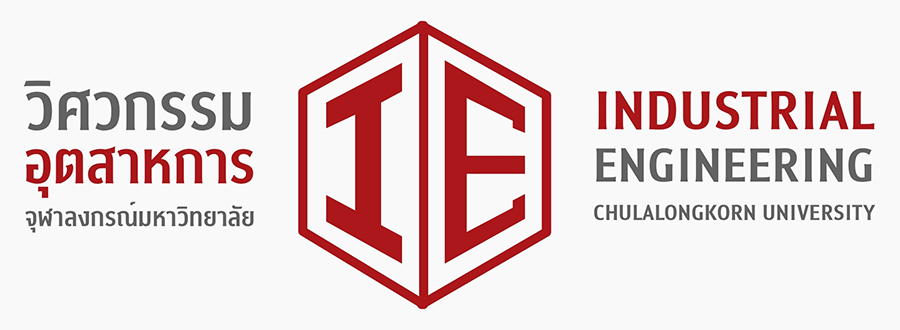- Home
- /
- Amonsiri Vilasdaechanont

Asst. Prof. Amonsiri Vilasdaechanont, Ph.D.
- 7th Floor of Engineering 4 Bldg., Room 711
- amonsiri.v@chula.ac.th
Education
Ph.D. (Industrial Engineering)
University of Wisconsin-Madison, United States, 2016
MS.C. (Industrial Engineering)
Columbia University in the City of New York, United States, 2009
วิศวกรรมศาสตรมหาบัณฑิต (วิศวกรรมอุตสาหการ)
จุฬาลงกรณ์มหาวิทยาลัย, 2007
วิศวกรรมศาสตรบัณฑิต (วิศวกรรมอุตสาหการ)
จุฬาลงกรณ์มหาวิทยาลัย, 2005
Expertise
Manufacturing & Service Systems
Statistics & Data Analysis
Publications
2024
Racha Lertsakwanit, Amonsiri Vilasdaechanont
Ocular Prosthesis Fabrication Scheduling Using Genetic Algorithm Journal Article
In: Engineering Journal, vol. 28, no. 11, pp. 69 – 79, 2024, ISSN: 01258281, (Cited by: 0; All Open Access, Gold Open Access).
@article{Lertsakwanit202469,
title = {Ocular Prosthesis Fabrication Scheduling Using Genetic Algorithm},
author = {Racha Lertsakwanit and Amonsiri Vilasdaechanont},
url = {https://www.scopus.com/inward/record.uri?eid=2-s2.0-85211902150&doi=10.4186%2fej.2024.28.11.69&partnerID=40&md5=741779df0c1862a54ba9a102e4ba5ba9},
doi = {10.4186/ej.2024.28.11.69},
issn = {01258281},
year = {2024},
date = {2024-01-01},
journal = {Engineering Journal},
volume = {28},
number = {11},
pages = {69 – 79},
publisher = {Chulalongkorn University, Faculty of Fine and Applied Arts},
abstract = {This research examines an ocular prosthesis centre’s operation and incorporates scheduling decision techniques to optimise its fabrication. A customised eye prosthesis is a make-to-order product which involves several labour-intensive processes and inherently poses scheduling challenges. As a result, patients' fitment dates are appointed with extra time to account for potential delays. The objective of scheduling is to minimise both total completion time and tardiness. The methodology begins with a process review of the customised eye prosthesis fabrication and criteria. Subsequently, a Mixed Integer Linear Programming (MILP) model is formulated to solve the assignment and sequencing problems. It is found during this stage that computational time increases significantly as the number of orders increases. To solve this problem, a Genetic Algorithm (GA) is proposed to find a near-optimal solution in a reasonable computational time. Instances selected for experiment are based on characteristics of a tertiary hospital’s ocular prosthesis centre. Small instances are experimented to validate the proposed algorithm against the MILP model. The GA demonstrates near-optimal solutions with a variance of one percent, with reasonable computational time. Practical-size problems are subsequently solved using the proposed algorithm. In conclusion, the proposed GA yields satisfactory solutions with acceptable runtime for this application. © 2024, Chulalongkorn University, Faculty of Fine and Applied Arts. All rights reserved.},
note = {Cited by: 0; All Open Access, Gold Open Access},
keywords = {},
pubstate = {published},
tppubtype = {article}
}
2020
P. Buathong, A. Vilasdaechanont
vol. 784, no. 1, Institute of Physics Publishing, 2020, ISSN: 17578981, (Cited by: 0; All Open Access, Gold Open Access).
@conference{Buathong2020,
title = {Development of Decision Support System for Solving the Machine Selection Problem in an Intermittent Manufacturing System Design},
author = {P. Buathong and A. Vilasdaechanont},
url = {https://www.scopus.com/inward/record.uri?eid=2-s2.0-85083186266&doi=10.1088%2f1757-899X%2f784%2f1%2f012022&partnerID=40&md5=ec3778c4fef310a796b7c7ebb63efc84},
doi = {10.1088/1757-899X/784/1/012022},
issn = {17578981},
year = {2020},
date = {2020-01-01},
journal = {IOP Conference Series: Materials Science and Engineering},
volume = {784},
number = {1},
publisher = {Institute of Physics Publishing},
abstract = {Capacity planning, which is integral to resource selection and allocation, is an important task in manufacturing system design. As budget is limited, investment in resources must be done carefully and appropriately in order to achieve desired capacity and system efficiency. One of the most expensive and valuable resources in the manufacturing system is machinery. Therefore, selecting an appropriate machine is of high significance. Among many types of manufacturing systems, intermittent manufacturing system is complex, yet flexible. The intermittent manufacturing system enables manufacturers to produce multiple products using multiple processes and multiple machines. The system comprises a network of multiple types of multi-process machines. A machine selection problem in the context of the intermittent manufacturing system is a delicate process, as it must correspond appropriately with production complexities. To alleviate this problem, we develop a decision support system for solving the machine selection problem in an intermittent manufacturing system design. We study several manufacturing systems producing multiple types of products with various multi-process machines to lay out the framework. This decision support system consists of four main parts, namely; data entry, data conversion, optimization model and report. To solve the machine selection problem, an optimization technique is used to identify the optimal number of machines and the allocation of production process of each machine. The objective of this optimization problem is to minimize total production costs (machine cost and operating cost) while maintaining production capacity and other production constraints. The decision support system is developed for and validated with the manufacturing company. © Published under licence by IOP Publishing Ltd.},
note = {Cited by: 0; All Open Access, Gold Open Access},
keywords = {},
pubstate = {published},
tppubtype = {conference}
}
Thitiwat Chunthanom, Amonsiri Vilasdaechanont
Production cost analysis of plastic woven sack manufacturer Conference
Association for Computing Machinery, 2020, ISBN: 978-145037546-7, (Cited by: 0).
@conference{Chunthanom202049,
title = {Production cost analysis of plastic woven sack manufacturer},
author = {Thitiwat Chunthanom and Amonsiri Vilasdaechanont},
url = {https://www.scopus.com/inward/record.uri?eid=2-s2.0-85092713638&doi=10.1145%2f3416028.3416038&partnerID=40&md5=7e7b64fad22146e5412ce10ef5f4c9da},
doi = {10.1145/3416028.3416038},
isbn = {978-145037546-7},
year = {2020},
date = {2020-01-01},
journal = {ACM International Conference Proceeding Series},
pages = {49 – 53},
publisher = {Association for Computing Machinery},
abstract = {The plastic woven sack industry in Thailand is increasingly growing and competitive due to a lot of operators and price competition. The accuracy of production cost is vital for decision making in management, effect to selling price and impact the organization profit. We study at a fully integrated plastic woven sack factory. The cost calculation method of the case study manufacturer currently does not reflect the actual production cost. The purpose of this study is to analyze and develop the production cost calculation method to estimate the production cost more precisely. The study begins with laying out the production structure and concepts of production cost calculation from the cost model. It consists of direct material costs, direct labor costs and production overhead costs. Direct materials costs are calculated from the material usage in the production which includes the material in product and loss of material in any of production process. The material usage along the production is analyzed and the direct material cost is calculated under the material balance concept, which is different from the traditional calculation method that does not considered the material loss in the production. The proposed calculation method for direct labor cost is set to reflect an actual labor cost of the production, while in the traditional method, labor cost is counted in the overhead cost. Production overhead costs proposed in this study are different from the traditional calculation methods by considering all of overheads in the model. The result of the study shows that the traditional method overestimates the unit production cost. The cost difference between both methods is around 10 percent. An average direct material cost of the proposed method is higher than the traditional method by 7 percent as the material loss occurred in the production process is included. Since direct labor cost is not considered separately and counted in overhead cost in the traditional method, we analyses them together. According to the analysis, we find that they are overestimated in traditional method for 27 percent. © 2020 ACM.},
note = {Cited by: 0},
keywords = {},
pubstate = {published},
tppubtype = {conference}
}
2018
S. Jongcheveevat, N. Phumchusri, A. Vilasdaechanont
vol. 2019-December, IEEE Computer Society, 2018, ISSN: 21573611, (Cited by: 1).
@conference{Jongcheveevat20181451,
title = {Optimal Overbooking Decision for Perishable Resources with Jointly Stochastic Booking and Show-up Requests},
author = {S. Jongcheveevat and N. Phumchusri and A. Vilasdaechanont},
url = {https://www.scopus.com/inward/record.uri?eid=2-s2.0-85061768426&doi=10.1109%2fIEEM.2018.8607490&partnerID=40&md5=fe970afe131699b980872dc984321749},
doi = {10.1109/IEEM.2018.8607490},
issn = {21573611},
year = {2018},
date = {2018-01-01},
journal = {IEEE International Conference on Industrial Engineering and Engineering Management},
volume = {2019-December},
pages = {1451 – 1455},
publisher = {IEEE Computer Society},
abstract = {Overbooking is a methodology in revenue management to optimize important decision making for perishable resources or services with uncertain demand. Overbooking allows an incoming booking to be accepted in exceedance of an available capacity because it is believed that some booking will be cancelled later. It is a complicated and risky decision since the decision maker needs to minimize both outsourcing cost and opportunity-lost cost simultaneously. When there are two classes of resources, it is not necessary to always outsource the insufficient and Iow-priced resources. Upgrading customers to high-priced resources is possible. The objective of this research is to develop overbooking models for (1) one class of resources and (2) two classes of resources (ie, high and low price) to minimize total cost i. e., opportunity cost, cost of upgrading and outsource cost). The main contribution of this research is that, unlike other existing literatures, the opportunity cost considered is specifically identified in the situation where too much booking request rejection of each type of resources is present. Sensitivity analysis of our model is also shown for managerial insights. © 2018 IEEE.},
note = {Cited by: 1},
keywords = {},
pubstate = {published},
tppubtype = {conference}
}
